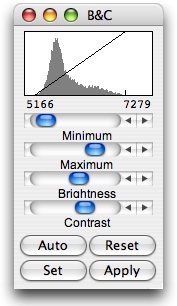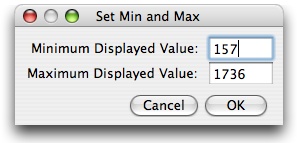−Table of Contents
Adjust
This submenu contains commands that adjust brightness/contrast, window/level, color balance, threshold levels and image/canvas size.
Brightness/Contrast...
Use this tool to interactively alter the brightness and contrast of the active image. With 8-bit images, brightness and contrast are changed by updating the image's look-up table (LUT), so pixel values are unchanged until the “Apply” button is pressed. With 16-bit and 32-bit images, the display is updated by changing the mapping from pixel values to 8-bit display values, so pixel pixel values are also unchanged. Brightness and contrast of RGB images are changed by modifying the pixel values.
Press shift-c to open the B&C window the quick and easy way. If it is already open, it is activated.
The line graph at the top of the window, which us superimposed on the image's histogram, shows how pixel values are mapped to 8-bit (0-255) display values. The two numbers under the plot are the minimum and maximum displayed pixel values. These two values define the display range, or “window”. ImageJ displays images by linearly mapping pixel values in the display range to display values in the range 0-255. Pixels with a value less than the minimum are displayed as black and those with a value greater than the maximum are displayed as white.
There are four sliders. Minimum and Maximum control the lower and upper limits of the display range. Brightness increases or decreases image brightness by moving the display range. Contrast increases or decreases contrast by varying the width of the display range. The narrower the display range, the higher the contrast.
Click on Auto, and ImageJ will automatically optimizes brightness and contrast based on an analysis of the image's histogram. Create a selection, and the entire image will be optimized based on an analysis of the selection. The optimization is done by allowing a small percentage of pixels in the the image to become saturated (displayed as black or white). Each additional click on Auto increases the number of saturated pixels and thus the amount of optimization.
Click on Reset to restore the original brightness and contrast settings. The display range is set to the full pixel value range of the image. A resetMinAndMax() macro call is generated if the command recorder is running.
Click on Set to enter the minimum and maximum display range values in a dialog box. A setMinAndMax() macro call is generated if the command recorder is running. Check Propagate to all open images to apply these values to the rest of the images currently open.
Click on Apply to apply the current display range mapping function to the pixel data. If there is a selection, only pixels within the selection are modified. This option currently only works with 8-bit images and stacks and with RGB stacks. This is the only B&C option that alters the pixel data of non-RGB images. For composite images it propagates the current image's display range to the other channels.
Window/Level
This command interactively alters the window (range of minimum and maximum) and level (position of that range in the greyscale intensity space) of the active image
Click on Auto, and ImageJ will automatically optimizes window and level based on an analysis of the image's histogram. Create a selection, and the entire image will be optimized based on an analysis of the selection. The optimization is done by allowing a small percentage of pixels in the the image to become saturated (displayed as black or white). Each additional click on Auto increases the number of saturated pixels and thus the amount of optimization.
Click on Reset to restore the original brightness and contrast settings. The display range is set to the full pixel value range of the image. A resetMinAndMax() macro call is generated if the command recorder is running.
Click on Set to enter the window level (center) and width values in a dialog box. A setMinAndMax() macro call is generated if the command recorder is running. Check Propagate to all open images to apply these values to the rest of the images currently open.
For 8-bit images (8-bit grayscale, RGB images or stacks), click Apply to modify the image data to reflect the current settings.
Color Balance...
This panel makes adjustments to the brightness and contrast of a single color of a standard RGB image (8 bits per color channel). Use the selection to specify which color will be adjusted; the histogram is drawn for the color selected. (For 48-bit color images that load as a stack, also the Image>Adjust>Brightness/Contrast tool works on single stack slices, i.e., colors, and the color settings of the Color Balance panel are ignored).
The sliders Minimum and Maximum control the lower and upper limits of the display range. Brightness increases or decreases image brightness by moving the display range.
Click on Auto, and ImageJ will automatically optimize brightness and contrast of the color selected based on an analysis of the image's histogram. Repeated clicking on Auto narrows down the display range, i.e. increases contrast and color saturation.
Reset reverts the display range to 0-255 for images with 8 bits per channel or the full display range for 16-bit and 32-bit images.
Click on Set to enter the minimum and maximum display range values in a dialog box. Check Propagate to all open images to apply these values to the rest of the images currently open.
For 8-bit images (8-bit grayscale, RGB images or stacks), click Apply to modify the image data to reflect the current settings. When switching from one color to another, the changes made to one color will be lost unless Apply is clicked before.
Threshold...
Use this tool to interactively set lower and upper threshold values, segmenting the image into features of interest and background. Pixels with brightness values greater than or equal to the lower threshold and less than or equal to the upper threshold are displayed in red. Use Analyze>Measure (with “Limit to Threshold” in Analyze>Set Measurements checked) to measure the aggregate of the selected features. Use Analyze>Analyze Particles to measure features individually. Use the wand tool to outline a single feature.
Use the upper slider to adjust the minimum threshold value and the lower one to adjust the maximum. Hold the Alt key down while adjusting the minimum to move a fixed-width thresholding window across the range of gray values (similar to Level, above).
The Auto button automatically sets the threshold levels based on an analysis of the histogram of the current image or selection. Apply sets thresholded pixels to black and all other pixels to white. However if Process>Binary>Options>Black Background is checked, the thresholded pixels are set to white and all other pixels to black. Reset disables thresholding and updates the histogram.
Red shows the thresholded values in red. Black & White switches to a mode where features are displayed in black and background in white, while Over/Under shows pixels in blue (lower than the low threshold) or in grey (larger than the maximum threshold value). Click on Set to enter new threshold levels into a dialog box.
Size...
Scales the active image or selection to a specified width and height in pixels.
Check Constrain Aspect Ratio to create an image with the specified Width and have ImageJ adjust the Height to maintain the original aspect ratio.
Check Interpolate to use bilinear interpolation. Set the new Width to 0 to create an image with the specified height and have ImageJ adjust the width to maintain the original aspect ratio.
Canvas Size...
Changes the canvas size of an image or stack without scaling the actual image. The Width and Height may be either expanded or contracted. If the canvas size is increased, then the border is filled with the current background color. Or, if Zero Fill is checked, the border is filled with pixels that have a value of zero. Use the Image>Color>Color Picker tool to change the background color. The position of the old image within the new canvas may also be specified (Center, Top Left, etc.).



